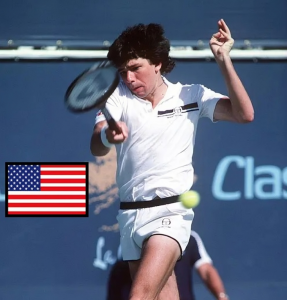Jimmy Arias
Born: August 16, 1964 in Grand Island (New York)
Height: 1.74 m
Plays: Right-handed
Alongside Aaron Krickstein (their match in Antwerp ’86), Arias was expected to succeed Jimmy Connors and John McEnroe at the zenith of U.S. tennis in the second half of the 1980s. They were both the inaugural “products” of Nick Bollettieri’s renowned academy, prodigies, hypothetical US versions of Björn Borg. Arias was merely 16 years and 10 months old when he claimed his first significant title – the mixed-doubles crown at the French Open ’81, partnering his  female counterpart Andrea Jaeger; a few months earlier, he’d become the youngest player (at the time) to compete in the US Open, losing in straight sets to Roscoe Tanner in the second round.
female counterpart Andrea Jaeger; a few months earlier, he’d become the youngest player (at the time) to compete in the US Open, losing in straight sets to Roscoe Tanner in the second round.
He entered the Top 100 before turning 17, and the pinnacle of his career unfolded around age 20 – he shockingly triumphed in Rome ’83, then proved his mettle in prestigious tournaments where was stopped in later stages by the era’s top three players (US Open, Dallas, French Open), and a soon-to-be top player Stefan Edberg in the first Open Era Olympic Games – as a demonstration sport for the second time in sixty years (only 21 year-old or younger men could participate). He ascended to the Top 5 as a teenager, yet those three hyperlinked lost matches to the game’s giants exposed his limitations; while it was improbable he’d become the world’s best, few anticipated his descent into mediocrity in the latter 1980s (his sole notable result being the Monte Carlo ’87 final).
Arias exemplified rapid exploitation. He had secured five titles before turning twenty and added none to his résumé thereafter (losing seven finals in the years 1985-1991). Still relatively young at 30 years old, he retired following several lackluster years and persistent injuries. Unexpectedly, he re-emerged for his cameo ATP event four years later – navigating the qualifying rounds in Washington ’98 (defeating Doug Flach and Eric Taino) to capitalize on a favorable draw, and Wade McGuire’s (poor 7-20 main-level record) injury in the first round… though he stood no chance against Wayne Ferreira in the second round.
Arias reflects on his career: “At 19, I made one critical mistake that altered my career. I contracted mono and continued playing, which enlarged my spleen and triggered liver issues. I was prescribed three months of bed rest. I began reviewing all the scrapbooks my mother had compiled, and I had two troubling thoughts: the first was, ‘if I never accomplish anything else in tennis, I’ve already done well.’ What you say manifests. I never truly achieved anything else I deemed noteworthy, though I won some significant matches. The second thought was even more unsettling: ‘I didn’t want to be No. 1 in the world anymore.’ The fame was too intense for my liking. I wanted to enjoy a movie without everyone recognizing me.” Yet the truth is that under Bollettieri’s guidance, Arias honed a potent top-spin forehand with a wooden racquet; it was a period of transition to graphite, and from the mid-1980s onward, several moderate players adeptly countered Arias’ top-spins once equipped with modern gear. Moreover, Arias’ backhand lacked fluidity; being short in stature, once his primary weapon was neutralized, he had no other arsenal to challenge the best guys on the tour.
Trivia: Arias was implicated in arguably the most humiliating defeat of the U.S. Davis Cup team in the 1980s. In the 1987 first round, Americans travelled to Paraguay as overwhelming favorites; Arias lost two rubbers, the second pivotal one against the obscure Hugo Chapacu [ranked 282] after 5 hours and 22 minutes, squandering three match points, the first two while leading 5:1 (40/15) in the decider! Another striking Arias defeat in the 1980s occurred at Barcelona ’84, where he fell in the quarterfinals to Sweden’s Joakim Nyström 6-2, 4-6, 14-16 – Arias trailed 1:5 in the third set yet held a match point at 12:11. That unfortunate loss actually meant Arias’ departure from the tennis elite.
Career record: 283–222 [ 222 events ]
Career titles: 5
Highest ranking: No. 5
Best GS results:
Roland Garros (quarterfinal 1984)
US Open (semifinal 1983)
World Team Cup champion 1984
Bronze medallist of the Olympics (Los Angeles ’84)
This entry was posted in
Players. Bookmark the
permalink.



Activity: 1980 – 1994
Five-setters: 8–7 (53%)
Tie-breaks: 108–88 (55%)
Deciding 3rd set TB: 12-9 (57%)
Defeats by retirement: 2
Walkovers given: 0